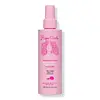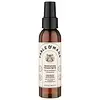What's inside
What's inside
 Key Ingredients
Key Ingredients

No key ingredients
 Benefits
Benefits

 Concerns
Concerns

 Ingredients Side-by-side
Ingredients Side-by-side

Water
Skin ConditioningPolysorbate 20
EmulsifyingOctylacrylamide/Acrylates/Butylaminoethyl Methacrylate Copolymer
Sodium Polystyrene Sulfonate
Emulsion StabilisingFurcellaria Lumbricalis Extract
Skin ConditioningWater, Polysorbate 20, Octylacrylamide/Acrylates/Butylaminoethyl Methacrylate Copolymer, Sodium Polystyrene Sulfonate, Furcellaria Lumbricalis Extract, Panthenol, Caprylic/Capric Triglyceride, Argania Spinosa Kernel Oil, Rosmarinus Officinalis Leaf Extract, Parfum, Citric Acid, Aminomethyl Propanol, Phenoxyethanol, Ethylhexylglycerin
Water
Skin ConditioningPropanediol
SolventGlycerin
HumectantPyrus Malus Fruit Extract
Skin ConditioningSaccharomyces Cerevisiae Extract
Skin ConditioningTocopherol
AntioxidantBacopa Monnieri Extract
Skin ConditioningEclipta Prostrata Extract
Skin ConditioningAllium Cepa Bulb Extract
Skin ConditioningTrigonella Foenum-Graecum Seed Extract
PerfumingAloe Barbadensis Leaf Juice
Skin ConditioningHelianthus Annuus Seed Oil
EmollientTetrahexyldecyl Ascorbate
AntioxidantHelianthus Annuus Seed Extract
Skin ConditioningCentella Asiatica Extract
CleansingCurcuma Longa Root Extract
MaskingHydrolyzed Wheat Protein
Skin ConditioningHydrolyzed Wheat Starch
Skin ConditioningWheat Amino Acids
Skin ConditioningPhenoxyethanol
PreservativeCetearamidoethyldiethonium Succinoyl Hydrolyzed Pea Protein
CleansingPPG-26-Buteth-26
Skin ConditioningPEG-40
HumectantHydrogenated Castor Oil
EmollientPolyquaternium-4
Tetrasodium Glutamate Diacetate
Disodium EDTA
Ethylhexylglycerin
Skin ConditioningButylene Glycol
HumectantCitric Acid
BufferingPotassium Sorbate
PreservativeLeuconostoc/Radish Root Ferment Filtrate
AntimicrobialSodium Benzoate
MaskingParfum
MaskingBenzyl Salicylate
PerfumingLimonene
PerfumingHydroxycitronellal
PerfumingCitronellol
PerfumingWater, Propanediol, Glycerin, Pyrus Malus Fruit Extract, Saccharomyces Cerevisiae Extract, Tocopherol, Bacopa Monnieri Extract, Eclipta Prostrata Extract, Allium Cepa Bulb Extract, Trigonella Foenum-Graecum Seed Extract, Aloe Barbadensis Leaf Juice, Helianthus Annuus Seed Oil, Tetrahexyldecyl Ascorbate, Helianthus Annuus Seed Extract, Centella Asiatica Extract, Curcuma Longa Root Extract, Hydrolyzed Wheat Protein, Hydrolyzed Wheat Starch, Wheat Amino Acids, Phenoxyethanol, Cetearamidoethyldiethonium Succinoyl Hydrolyzed Pea Protein, PPG-26-Buteth-26, PEG-40, Hydrogenated Castor Oil, Polyquaternium-4, Tetrasodium Glutamate Diacetate, Disodium EDTA, Ethylhexylglycerin, Butylene Glycol, Citric Acid, Potassium Sorbate, Leuconostoc/Radish Root Ferment Filtrate, Sodium Benzoate, Parfum, Benzyl Salicylate, Limonene, Hydroxycitronellal, Citronellol
Ingredients Explained
These ingredients are found in both products.
Ingredients higher up in an ingredient list are typically present in a larger amount.
Citric Acid is an alpha hydroxy acid (AHA) naturally found in citrus fruits like oranges, lemons, and limes.
Like other AHAs, citric acid can exfoliate skin by breaking down the bonds that hold dead skin cells together. This helps reveal smoother and brighter skin underneath.
However, this exfoliating effect only happens at high concentrations (20%) which can be hard to find in cosmetic products.
Due to this, citric acid is usually included in small amounts as a pH adjuster. This helps keep products slightly more acidic and compatible with skin's natural pH.
In skincare formulas, citric acid can:
While it can provide some skin benefits, research shows lactic acid and glycolic acid are generally more effective and less irritating exfoliants.
Most citric acid used in skincare today is made by fermenting sugars (usually from molasses). This synthetic version is identical to the natural citrus form but easier to stabilize and use in formulations.
Read more about some other popular AHA's here:
Learn more about Citric AcidEthylhexylglycerin (we can't pronounce this either) is commonly used as a preservative and skin softener. It is derived from glyceryl.
You might see Ethylhexylglycerin often paired with other preservatives such as phenoxyethanol. Ethylhexylglycerin has been found to increase the effectiveness of these other preservatives.
Parfum is a catch-all term for an ingredient or more that is used to give a scent to products.
Also called "fragrance", this ingredient can be a blend of hundreds of chemicals or plant oils. This means every product with "fragrance" or "parfum" in the ingredients list is a different mixture.
For instance, Habanolide is a proprietary trade name for a specific aroma chemical. When used as a fragrance ingredient in cosmetics, most aroma chemicals fall under the broad labeling category of “FRAGRANCE” or “PARFUM” according to EU and US regulations.
The term 'parfum' or 'fragrance' is not regulated in many countries. In many cases, it is up to the brand to define this term.
For instance, many brands choose to label themselves as "fragrance-free" because they are not using synthetic fragrances. However, their products may still contain ingredients such as essential oils that are considered a fragrance by INCI standards.
One example is Calendula flower extract. Calendula is an essential oil that still imparts a scent or 'fragrance'.
Depending on the blend, the ingredients in the mixture can cause allergies and sensitivities on the skin. Some ingredients that are known EU allergens include linalool and citronellol.
Parfum can also be used to mask or cover an unpleasant scent.
The bottom line is: not all fragrances/parfum/ingredients are created equally. If you are worried about fragrances, we recommend taking a closer look at an ingredient. And of course, we always recommend speaking with a professional.
Learn more about ParfumPhenoxyethanol is a preservative that has germicide, antimicrobial, and aromatic properties. Studies show that phenoxyethanol can prevent microbial growth. By itself, it has a scent that is similar to that of a rose.
It's often used in formulations along with Caprylyl Glycol to preserve the shelf life of products.
Water. It's the most common cosmetic ingredient of all. You'll usually see it at the top of ingredient lists, meaning that it makes up the largest part of the product.
So why is it so popular? Water most often acts as a solvent - this means that it helps dissolve other ingredients into the formulation.
You'll also recognize water as that liquid we all need to stay alive. If you see this, drink a glass of water. Stay hydrated!
Learn more about Water